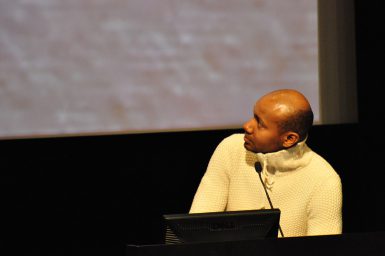Rebirth of a Nation: Remix changes racism of original

Writer, composer and artist Paul Miller (aka DJ Spooky) sought to change the tone and message of one of the most controversial films in history by remixing and editing the original Birth of a Nation.
What he couldn’t have predicted was the timing of the remix, Rebirth of a Nation, would come when people are debating facts and reality on the political stage.
“I expected it to be controversial,” he said in his Jorgensen Lecture at IU Cinema last week. “But instead, it’s been a talking point.”
Rebirth of a Nation is an edited and “re-mixed” interpretation of D.W. Griffith’s infamous Birth of a Nation. The silent film, which first premiered in 1915, chronicles the lives of a few characters from the Civil War all the way through several years of Reconstruction. It is often viewed as Ku Klux Klan propaganda due to its depiction of black people as uneducated and dangerous and of the KKK as heroes.
Citing the election of Donald Trump and the increase in the distrust in facts, Miller said this “talking point” is a positive development.
“I’ve noticed there is now an ideological presentation of reality,” he said. “People are combining emotion and logic, and it’s hard to counter that anymore.”
Two of the story’s main characters are a biracial man who slowly has risen up in power after the freedom of slaves and a white man who founds the KKK in order to stop the biracial man from gaining power.
“Sound familiar?” Miller said as he introduced the piece before the screening.

After the screening, Miller talked and answered questions from the audience. He said he sought to turn the racist sentiment of the original film on its head with his use of editing. The final product is a nonlinear piece with maps, geometric shapes and other figures overlaid on the old film and DJ Spooky’s original music, played by the Kronos Quartet, then remixed with hip hop beats underneath. Miller described the end product, which lasts about an hour and a half, as “and unexpected collision of history and editing.”
One of the more noticeable parts of the film is Miller’s use of shapes, maps and images overlaying the film. “The two combined make an interesting juxtaposition,” said one of the audience members.
“Slavery set industry and agriculture in opposition,” Miller explained. “I edited the scenes to have multiple trajectories.”
For example, his frequent use of a cotton blossom serves as a motif for the relationship between past and present.
Another noteworthy part of the piece as an art form is the use of music, all of which Miller composed and remixed himself. He said the music that the Kronos Quartet played was based heavily in blues and gospel, which he edited with simple hip hop beats.
“Kronos was exquisite,” Miller said. “And we weren’t even in the same room together at all to make this. I would send Kronos different pieces of the music, and a little later they would send back high-res motifs. Then I would remix and layer them and then send it back to Kronos, and they would layer more music on top of that.”

Cennie Scott, a freshman studying business who came to see Rebirth of a Nation, described it as elaborate.
“Our world is constantly changing and we have a long way to go,” said Scott. “It’s important that we still educate people about the important issues in our history.”
Miller said the same of his work.
“These are strange times,” he said. “Film is a mirror we hold up to reality and, with that, we can meditate on what the future holds.”
Miller’s campus visit was co-sponsored by The Media School and arranged by associate professor Joan Hawkins.
More:

